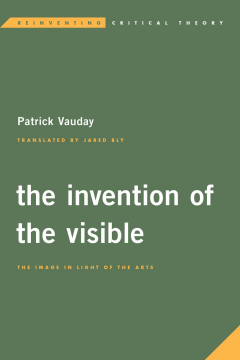
Additional Information
Book Details
Abstract
We live in a mediatized society, a society one could call a society of images. Working at the intersection of aesthetics and politics, Patrick Vauday challenges the dominant assumptions of this society and its disposition towards images. This challenge does not advocate repudiating images altogether, but rather entreats us to see them in a different light. This new way of thinking of images affords a glimpse into what images do and produce, rather than viewing them as copies or mere representations. Images are dynamic agents that are active in our world rather than simply empty reflections of it.
Rethinking the concept of the image in this fashion opens up new ways of interpreting and engaging with works of art. This reconsideration of the role of images in society is the starting point for a new politics that considers the multiple and complex efficacies by which images act, circulate and are created.
A masterful attempt to carve out a space for a consideration of images not bounded by emphases on a singular essence, invariable traits, or an ontological preference toward a pragmatics of images that opens up the possibility of political transformation in terms of heterogeneity, dynamic reconfiguration, and critical intervention. Refusing the either/or logic prevalent in contemporary art theory, the author persuasively shows that, too often, these dominant narratives obscure the heterogeneity of forces and relations amongst artists and artistic practices when confronting new forms, materialities, or media. This is an inspired account of the potentialities of art.
Janae Sholtz, Association Professor of Philosophy, Alvernia University
Vauday (philosophy, Université Paris 8, France) has two objectives for the present work: first, to highlight postwar French thought in aesthetics and, second, to examine its connection with contemporary theories of art related to the aesthetic status of images. Images are the primary focus—not images as mere representations or expressions but images as a shaping pragmatic, generating force. Vauday begins by tracing philosophy’s quarrels with the image and the bewitching charm of appearances, from Plato and Descartes to contemporary writers. He offers, by way of contrast, Aristotle, who considered the image as the rationalization of the sensible. This finds its modern extension in phenomenology, in which painting, cinema, and the other visible arts invest in the phenomenal world, enabling one to pass from an ontology of images (what is an image?) to the question of what images do—a pragmatic of images. The author explores concepts ranging from photographic prose, the impurity of cinema, and the image in the mirror of ontology to the politics of pictorial space, contemporary iconoclasm, and the counterimage…. Summing Up: Recommended. With reservations. Graduate students, researchers, faculty.
Patrick Vauday is Professor of Philosophy at the Université Paris 8. He is the author of several academic books in French.
Jared Bly is a Graduate Student in Philosophy at Villanova University.
The Invention of the Visible is destined to become a masterwork in the study of the contemporary image. The book is rich in examples from the fields of painting, photography and cinema and expertly shows how these artistic practices overlap and intersect. Vauday argues for a post-essentialist view of images, untethered from the classical model of representation, and freed in their creative power to produce practical effects that play with the material forces of their composition.
Walter Brogan, Villanova University
Not only does Patrick Vauday offer a lively and most remarkable introduction to the aesthetics of the image in French contemporary philosophy; he also demonstrates the important role played by the ‘Image Turn’ within this tradition. The Invention of the Visible invites us ‘to unmake and remake images’, enabling us to conceive of configurations of the world other than those of a phenomenology of art with which French philosophy has long been associated.
Eric Alliez, Professor, Professor of Contemporary French Philosophy, Kingston University and Professor of Aesthetics, Paris
Table of Contents
| Section Title | Page | Action | Price |
|---|---|---|---|
| The Invention of the Visible | Cover | ||
| Contents | v | ||
| Preface to the English Edition | vii | ||
| Acknowledgements | xvii | ||
| Introduction | xix | ||
| 1 The Image in the Mirror of Ontology | 1 | ||
| Plato: The Image or the Understudy of Being | 1 | ||
| Sartre: The Image or the Negation of Being | 12 | ||
| 2 Aesthetics: What Images Do | 23 | ||
| The Process-Image | 23 | ||
| Painting Outside of Itself | 25 | ||
| Photographic Prose | 31 | ||
| The Impurity of Cinema | 37 | ||
| 3 Poetics: Making Images | 45 | ||
| Manet: Painting and New Images | 45 | ||
| Photography: The Passage of the New | 54 | ||
| Cinema, Discovery | 59 | ||
| 4 Politics: Unmaking and Remaking Images | 75 | ||
| The Contemporary Iconoclasm | 75 | ||
| Regimes of the Image | 76 | ||
| Counter-Image | 80 | ||
| Extraction versus Abstraction | 84 | ||
| The Politics of the Pictorial Space | 87 | ||
| From One Space to Another: Courbet and Gauguin | 91 | ||
| Conclusion: Towards a Civilization of Images | 101 | ||
| Bibliography | 109 | ||
| Index | 115 |
